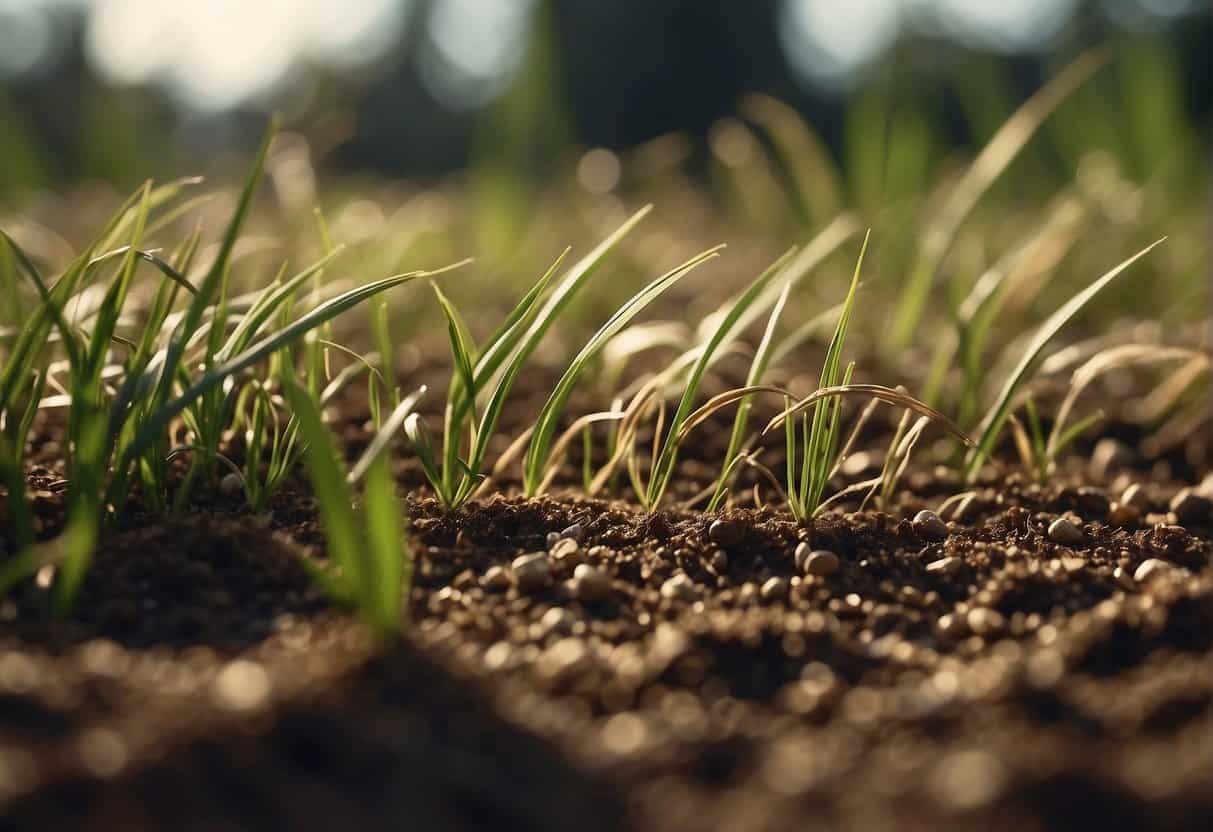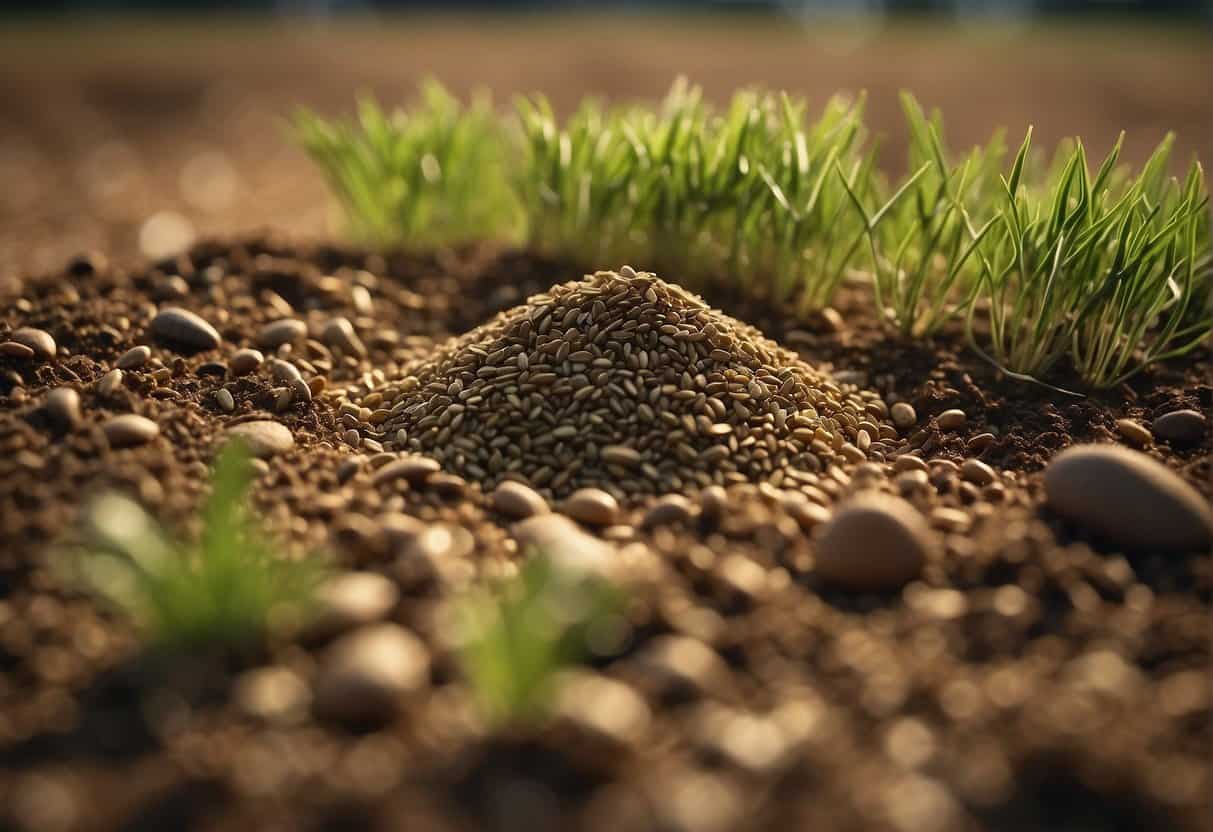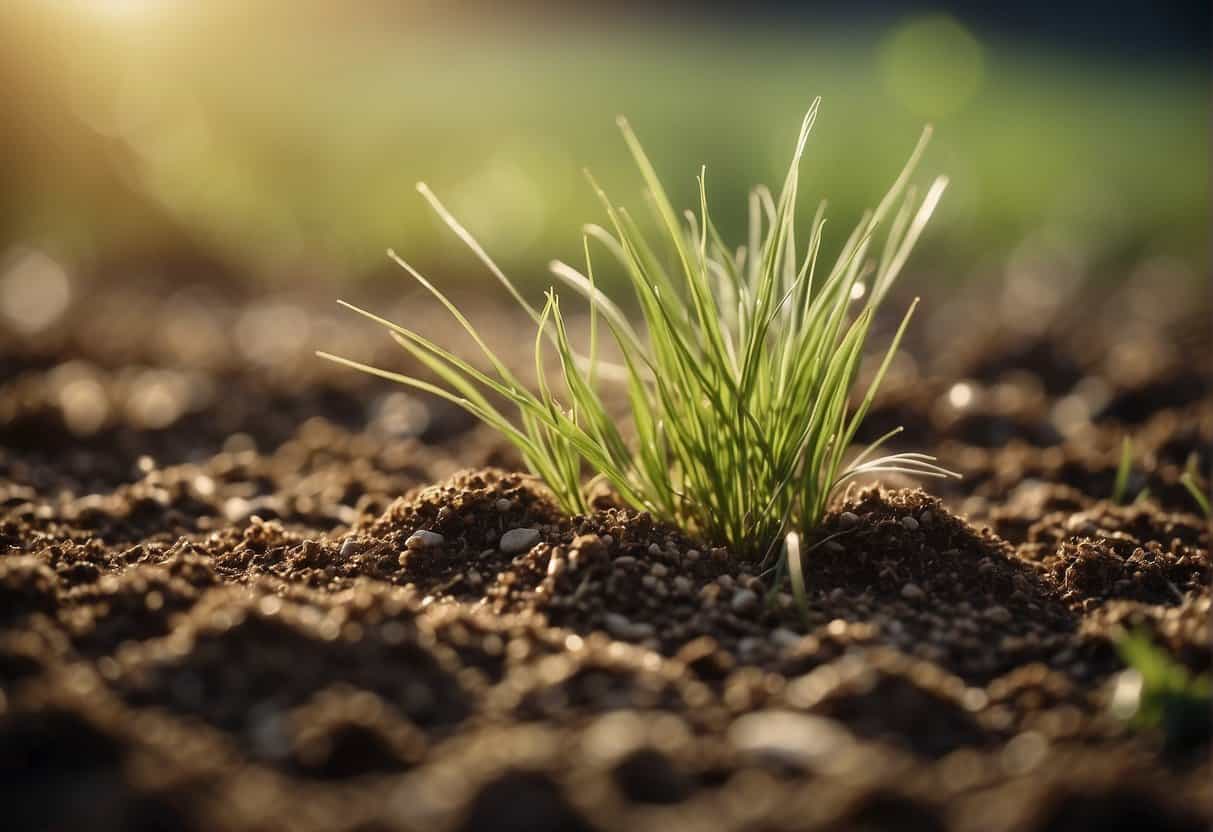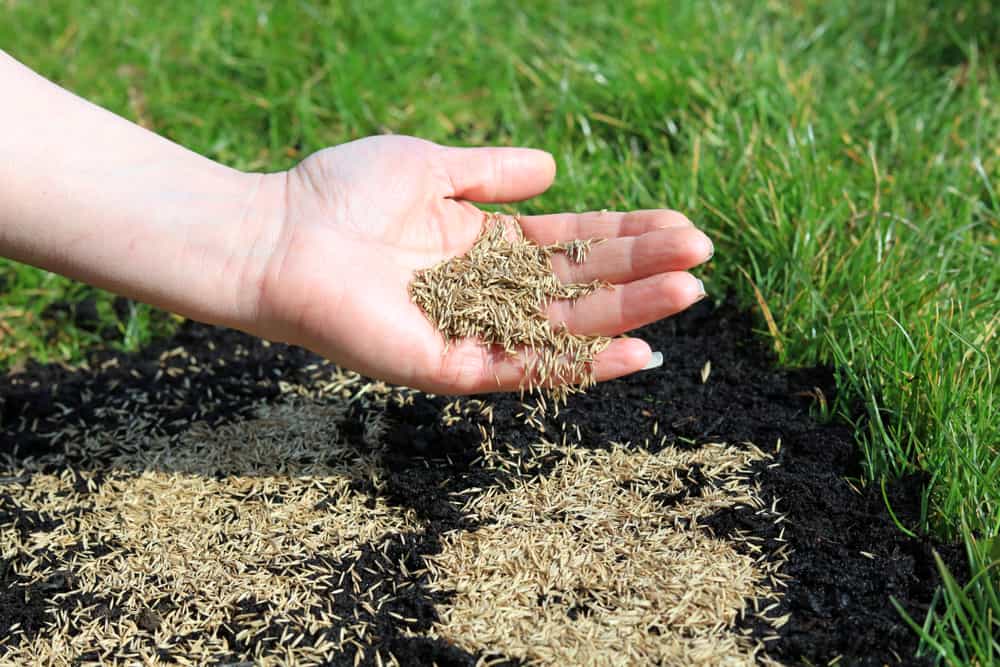When you’re setting out to create a lush green lawn from scratch, you might find yourself wondering whether those tiny grass seeds need to be tucked away beneath the soil to sprout successfully. It’s a common question – and for good reason. After all, you want to give your lawn the best start in life.
You might be surprised to learn that grass seeds don’t always need burying. A simple scatter on the surface could do, but beware – these exposed seeds face threats from birds and rain. The key? Tailoring your approach to your garden’s unique conditions, like soil type and local wildlife. Dive in to discover how to give your grass seeds the best chance to flourish.
Grass Seed Germination Basics
When you’re starting a new lawn or repairing patches of your existing one, understanding the basics of grass seed germination can make a world of difference. Here’s what you need to know:
- Light Requirements: Unlike many other seeds, grass seeds need light to germinate effectively, so there’s no need to bury them deep within the soil. Instead, lightly rake them into the top layer, ensuring they make contact with the soil without being covered completely.
- Soil Contact: Your grass seeds must have good contact with the soil. You can gently press them down or lightly cover them with a fine layer of soil or compost. This contact helps to retain moisture around the seed and provides stability as it starts to grow.
- Watering: Keep the soil consistently moist, but not waterlogged. This means frequent, light watering rather than less frequent, heavy soaks. Grass seedlings are delicate and can be disturbed by strong jets of water, so use a fine spray setting on your hose or a watering can with a rose attachment.
- Seasonal Timing: The best time to sow grass seeds depends on whether they are cool-season varieties (usually sown in early autumn) or warm-season types (best sown in late spring to early summer).
Remember, it’s all about creating the ideal conditions for your grass seeds to thrive:
- Moisture: Essential, but avoid sogginess.
- Temperature: Warmth is needed, but not extreme heat.
- Care: Gentle care with watering and handling.
With a bit of patience and the right approach, you’ll soon see the fruits of your labour sprout into a lush, green lawn.
Soil Preparation for Grass Seed
Before sowing your grass seeds, preparing the soil is vital for successful germination and growth. Begin by testing the soil pH, aiming for a neutral pH level around 7.0. Grasses can tolerate slightly acidic soil down to 6.0 pH. If the soil is too acidic or alkaline, consider adding lime or sulphur, respectively, to adjust it.
Add nutrients to the soil by incorporating organic matter. This will improve soil structure, increase water retention, and supply essential nutrients. You can use well-rotted compost, aged manure, or a quality soil improver.
Improve drainage if necessary, especially if your soil is clay-heavy. Aerating the area helps, as does mixing in sand or other materials that increase porosity and airflow.
Basic Steps for Soil Preparation:
Follow these 5 basic steps to get your soil ready for sowing the grass seeds:
- Clear the Area: Remove debris, stones, and existing vegetation.
- Loosen the Soil: Use a garden fork or tiller to a depth of 15-20cm to help roots establish.
- Enrich the Soil: Spread organic matter and work it into the soil.
- Level the Ground: Break up large clumps and create an even surface.
- Final Rake: Just before sowing, give the area a light rake to create a fine tilth.
Sowing Techniques
When you’re looking to establish a lush lawn, understanding the correct sowing technique is key. Whether you sprinkle seeds over the soil or plant them in rows, the method you choose will impact germination and growth.
Broadcasting Method
Broadcasting is the act of spreading grass seeds evenly over the prepared soil surface. For best results:
- Lightly rake the soil to create a loose bed which aids seed-to-soil contact.
- Scatter the seeds in two passes, one horizontally and the other vertically to ensure even distribution. Or, consider using a broadcast spreader to assist with evenly spreading the seeds, particularly if you are trying to cover large areas.
- Gently press seeds into the soil with the back of a rake or by walking over the area, which should not be more than a few millimetres deep.
Row Planting Method
The Row Planting Method involves sowing seeds in distinct rows, which can improve germination by:
- Allowing easier access to water and nutrients.
- Facilitating proper spacing is crucial for certain types of grass.
It is important to be aware that in most residential lawn settings, row planting is not practical due to aesthetic and maintenance considerations. For those interested in row planting for specific purposes, it’s important to research the specific needs and growth habits of the grass variety being considered.
To use this method:
- Create rows in the soil about 15 cm apart.
- Plant the seeds at the recommended depth, generally around 1 cm deep.
- Cover the rows lightly with soil to protect seeds from the elements and birds.
Ideal Conditions for Growth
To cultivate a lush lawn from grass seed, you need to create the ideal growth conditions. Paying attention to watering, climate, and sunlight is crucial.
Watering Requirements
Your grass seeds require consistent moisture to germinate successfully. Water lightly but frequently, ensuring the soil stays damp but not waterlogged. During the first few weeks after sowing, aim to water once or twice daily, depending on the weather conditions.
Temperature and Climate
Germination is influenced by soil temperature. The optimal range varies between grass species. Before planting, check the specific requirements of your chosen variant, as some thrive in warmer or cooler conditions. Avoid sowing during the extremes of summer or winter.
Sunlight Exposure
For the best results, your grass seed should receive plenty of sunlight—around 6 to 8 hours of direct light each day. If your lawn area is partly shaded, consider a grass variety that is tolerant to lower light levels.
Protection and Maintenance
Proper protection and maintenance of your freshly sown grass seeds are crucial for a healthy lawn. You’ll need to defend against birds and pests, ensure optimal seed-to-soil contact with the right coverings, and adhere to a fertilisation schedule for the best results.
Bird and Pest Deterrents
To safeguard your grass seeds from birds and pests, consider using physical barriers such as netting or floating row covers. These barriers will discourage birds from feasting on your seeds. You can also try reflective tapes or wind chimes nearby, as the movement and sound can deter birds.
Seed Coverings and Mulch
Seed coverings provide vital benefits; they improve seed-to-soil contact, retain soil moisture, and maintain appropriate soil temperature. Aim to apply a thin layer of soil, around 5 to 15 mm thick, over the seeds. Alternatively, you can use organic mulch like straw or compost, which will also help protect against erosion and provide nutrients as they decompose.
Fertilisation Schedule
Commence with a starter fertiliser when you plant your seeds to give them an essential nutrient boost. Following germination, mark your calendar for a seasonal fertilisation routine. Use a slow-release fertiliser once a year in early spring, which will continuously feed your lawn and encourage vigorous growth. Here’s a simplified schedule:
- Planting: Apply starter fertiliser.
- Early Spring: Feed with slow-release fertiliser.
- Maintenance: Spot-check for nutrient deficiencies and adjust as necessary.
Understanding Seed Types
When you’re looking to establish a new lawn or repair patchy areas, knowing the difference between cool-season and warm-season grass seeds is crucial. These types cater to different climates and will affect when and how you plant them.
Cool-Season Grasses
Cool-season grasses thrive in the cooler parts of Australia, like Tasmania and Victoria, where temperatures are moderate. These grasses are ideal for autumn planting as they can take advantage of the winter rainfall. Examples include:
- Perennial Ryegrass: Quick to establish and has a fine leaf texture.
- Tall Fescue: Tolerant of drought and shade, with a broad leaf blade.
Warm-Season Grasses
Warm-season grasses suit areas with hot summers and mild winters, such as Queensland and the Northern Territory. They grow best when sown in late spring or early summer. These grass types include:
- Buffalo Grass: Durable and able to withstand heavy foot traffic.
- Couch Grass: Requires sunshine and is resistant to warmer temperatures.
Troubleshooting Common Issues
When you’re trying to get a lush lawn from grass seeds, it’s frustrating when things don’t go as planned. A few snags can occur, such as seeds not germinating, weeds taking over, or disease and fungus appearing. Let’s look into what causes these issues and how to avoid them.
Poor Germination
Grass seeds may fail to germinate for several reasons. First, ensure they’re not buried too deeply; a light raking to cover the seeds with a thin layer of soil is sufficient. Grass seeds need light contact with the soil and consistent moisture to germinate effectively.
Watering twice daily for 5-10 minutes could significantly improve germination rates, keeping the soil moist (not waterlogged) to a depth of 2-5 cm. Remember, grass seeds won’t germinate if they dry out.
Weed Competition
Weeds can outcompete your grass seeds for nutrients and space, stunting lawn establishment. To combat this, start with a clean slate by removing existing weeds before sowing seeds. After planting, vigilant maintenance is key.
You can create a physical barrier, such as mulch, to deter weeds and also consider the use of pre-emergent herbicides that won’t affect the germination of your grass seeds.
Disease and Fungus
Grass seedlings are susceptible to disease and fungus, especially in overly wet conditions. To avoid this, don’t over-water your lawn and provide good air circulation. If you notice signs of disease or fungus, such as discoloured patches or unusual growths, reduce watering frequency and consider fungicide treatments suitable for new grass.
Practice preventive care by choosing disease-resistant seed varieties and ensuring proper lawn maintenance from the start.
Frequently Asked Questions
When tackling the growth of your grass, it’s crucial to address common inquiries to ensure that you’re on the right path to a lush lawn.
How can I ensure the successful germination of grass seed?
To enhance germination, make sure your grass seed has contact with the soil, keep the area moist without overwatering, and consider the timing of planting – ideally during growth seasons, which are typically spring and autumn in Australia.
What’s the best way to plant grass seed on an existing lawn?
Overseeding your existing lawn requires spreading grass seed evenly across the grass, gently raking it in, and ensuring the seeds are not buried too deep; a light cover with soil or compost can aid in protecting the seeds and retaining moisture.
Do I need to cover grass seed for it to grow properly?
While grass seed does not necessarily need to be buried, a thin cover of soil or mulch can protect it from birds and the elements, as well as help maintain the moisture needed for germination.
How long typically does it take for grass seed to sprout and establish?
Grass seeds can take anywhere from 5 to 30 days to germinate. The time needed for the grass to establish depends on the grass type, soil conditions, and climate, with most lawns establishing in 6 to 8 weeks.
Is it necessary to purchase new grass seed if mine is a couple of years old?
Grass seeds that are a few years old may have reduced germination rates. It’s a good idea to test a small amount by planting it or to purchase fresh seeds for the best results.
What are some effective methods to grow lush grass in Australian conditions?
Choose a grass variety suitable for the Australian climate, water your lawn in the early morning to reduce evaporation, use slow-release fertilisers and top-dress your lawn occasionally to maintain nutrient-rich soil and healthy grass.







